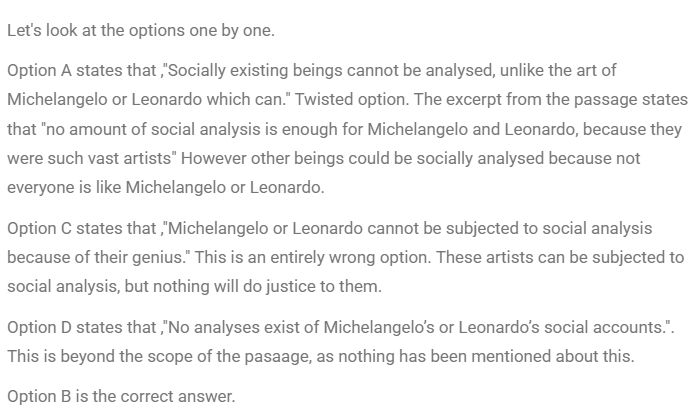CAT RC Questions | CAT RC Based on Humanities questions
FundaMakers is the Best CAT Online Coaching In India. Now prepare for CAT anytime with FundaMakers. We provide well-ordered syllabus coverage for both offline and online CAT preparation batches. FundaMakers brings to you the power-packed, well-structured CAT previous year question bank with more than 4000+ CAT Past Year questions. In the VARC section, one of the most frequently asked questions is from the topic- Reading Comprehension. Reading Comprehension turns out to be an important part of the VARC section from which over 60-70% of the questions are based on RC in the CAT Exam.
FundaMakers as a team has taken a painstaking step to bring you all the video solutions of the Reading Comprehension asked in the Previous Year CAT exam. CAT question bank offered by FundaMakers is a power-packed topic-wise compilation of the entire CAT previous year questions. Questions from the Reading Comprehension topic are some of the most scoring questions in the VARC section. To maximize your CAT score make use of FundaMakers CAT Question Bank. “Questions from CAT previous years” examination papers have been incorporated. Let’s get started with CAT Past Year Reading Comprehension Questions.
Comprehension
Directions for question: Read the passage carefully and answer the given questions accordingly
The passage below is accompanied by a set of questions. Choose the best answer to each question.
The claims advanced here may be condensed into two assertions: [first, that visual] culture is what images, acts of seeing, and attendant intellectual, emotional, and perceptual sensibilities do to build, maintain, or transform the worlds in which people live. [And second, that the] study of visual culture is the analysis and interpretation of images and the ways of seeing (or gazes) that configure the agents, practices, conceptualities, and institutions that put images to work. . . .
Accordingly, the study of visual culture should be characterized by several concerns. First, scholars of visual culture need to examine any and all imagery – high and low, art and nonart. . . . They must not restrict themselves to objects of a particular beauty or aesthetic value. Indeed, any kind of imagery may be found to offer up evidence of the visual construction of reality. . . .
Second, the study of visual culture must scrutinize visual practice as much as images themselves, asking what images do when they are put to use. If scholars engaged in this enterprise inquire what makes an image beautiful or why this image or that constitutes a masterpiece or a work of genius, they should do so with the purpose of investigating an artist’s or a work’s contribution to the experience of beauty, taste, value, or genius. No amount of social analysis can account fully for the existence of Michelangelo or Leonardo. They were unique creators of images that changed the way their contemporaries thought and felt and have continued to shape the history of art, artists, museums, feeling, and aesthetic value. But study of the critical, artistic, and popular reception of works by such artists as Michelangelo and Leonardo can shed important light on the meaning of these artists and their works for many different people. And the history of meaning-making has a great deal to do with how scholars as well as lay audiences today understand these artists and their achievements.
Third, scholars studying visual culture might properly focus their interpretative work on lifeworlds by examining images, practices, visual technologies, taste, and artistic style as constitutive of social relations. The task is to understand how artifacts contribute to the construction of a world. . . . Important methodological implications follow: ethnography and reception studies become productive forms of gathering information, since these move beyond the image as a closed and fixed meaning-event. . . .
Fourth, scholars may learn a great deal when they scrutinize the constituents of vision, that is, the structures of perception as a physiological process as well as the epistemological frameworks informing a system of visual representation. Vision is a socially and a biologically constructed operation, depending on the design of the human body and how it engages the interpretive devices developed by a culture in order to see intelligibly. . . . Seeing . . . operates on the foundation of covenants with images that establish the conditions for meaningful visual experience.
Finally, the scholar of visual culture seeks to regard images as evidence for explanation, not as epiphenomena.
CAT/2020.2
Question . 49
“No amount of social analysis can account fully for the existence of Michelangelo or Leonardo.” In light of the passage, which one of the following interpretations of this sentence is the most accurate?
Explanatory Answer
Method of solving this CAT RC Question from RC Based on Humanities question
Correct Option: B

Hey!
Worried about IIM calls due to your marks in 10th,12th, and Graduation?
Don't worry! Know your chances of getting an IIM Call based on your profile with our:-
Profile Professor: https://fundamakers.com/profile-professor/

5 Must- NOT-Dos during CAT Preparation.
- Do not treat CAT as 'Everything'.
- Do not quit your job for CAT exam preparation.
- Learning till The Eleventh hour instead of doing proper revision.
- Not checking the syllabus thoroughly.
- Piling up multiple books.
Click To Read:- Common mistakes made by CAT aspirants during preparation.
FundaMakers- Best Online and Offline CAT Online Preparation Institute in India
For any CAT Preparation related query, reach out to us at 9598333344.